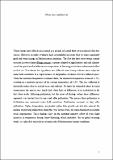Por favor, use este identificador para citar o enlazar a este item:
http://hdl.handle.net/10261/4386COMPARTIR / EXPORTAR:
 SHARE
BASE SHARE
BASE
|
|
| Visualizar otros formatos: MARC | Dublin Core | RDF | ORE | MODS | METS | DIDL | DATACITE | |

| Título: | Warm temperatures at bloom reduce fruit set in sweet cherry |
Autor: | Hedhly, Afif CSIC ORCID; Hormaza Urroz, José Ignacio CSIC ORCID ; Herrero Romero, María CSIC ORCID | Fecha de publicación: | 2007 | Editor: | Vereinigung für Angewandte Botanik | Citación: | Journal of Applied botany and Food Quality, 81 (2007): 158-164 | Resumen: | Warm springs have often been assumed as a prelude of a good fruit set in temperate fruit tree species. However, recently, evidences have accumulated on erratic fruit set under apparently good and warm springs in Mediterranean conditions. The fact that these observations mainly occurred in sweet cherry (Prunus avium), a species adapted to high latitudes and cold climates raised the question of whether warm temperatures at flowering could have a detrimental effect on fruit set. To evaluate this hypothesis two different sweet cherry cultivars were subjected under field conditions to a slight increase in temperature at bloom over two different years. While the minimum temperature remained stable, the maximum temperature increased 5-7ºC, resulting in a moderate increase of the average temperature of 1-3ºC. This was sufficient to drastically reduce fruit set in both years and cultivars. To know the vulnerable phase to warm temperatures the process was timed back: final fruit set differences were established in the first three weeks following pollination, but the onset of fruiting –when these differences appeared- was tracked back to one week after pollination. The process from pollination to fertilization was examined under both conditions. Fertilization occurred six days after pollination. Higher temperatures accelerated pollen tube growth rate but also reduced the number of growing pollen tubes along the style. In the ovary, the warm treatment accelerated ovule degeneration. These findings alert on the potential negative effect of even slight increases in temperature during cherry blooming, which nowadays -due to global warming trends- is a plausible and realistic scenario under Mediterranean climatic conditions. | URI: | http://hdl.handle.net/10261/4386 | ISSN: | 1613-9216 |
| Aparece en las colecciones: | (EEAD) Artículos (IHSM) Artículos |
Ficheros en este ítem:
| Fichero | Descripción | Tamaño | Formato | |
|---|---|---|---|---|
| JABFQ2007_AHedhly.pdf | 215,07 kB | Adobe PDF |  Visualizar/Abrir |
CORE Recommender
Page view(s)
914
checked on 24-abr-2024
Download(s)
815
checked on 24-abr-2024
Google ScholarTM
Check
NOTA: Los ítems de Digital.CSIC están protegidos por copyright, con todos los derechos reservados, a menos que se indique lo contrario.
